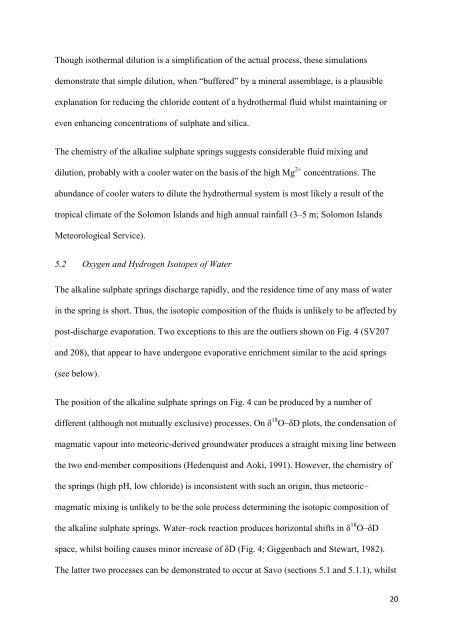Alkaline sulphate fluids produced in a magmatic hydrothermal system
Alkaline sulphate fluids produced in a magmatic hydrothermal system
Alkaline sulphate fluids produced in a magmatic hydrothermal system
Create successful ePaper yourself
Turn your PDF publications into a flip-book with our unique Google optimized e-Paper software.
Though isothermal dilution is a simplification of the actual process, these simulations<br />
demonstrate that simple dilution, when “buffered” by a m<strong>in</strong>eral assemblage, is a plausible<br />
explanation for reduc<strong>in</strong>g the chloride content of a <strong>hydrothermal</strong> fluid whilst ma<strong>in</strong>ta<strong>in</strong><strong>in</strong>g or<br />
even enhanc<strong>in</strong>g concentrations of <strong>sulphate</strong> and silica.<br />
The chemistry of the alkal<strong>in</strong>e <strong>sulphate</strong> spr<strong>in</strong>gs suggests considerable fluid mix<strong>in</strong>g and<br />
dilution, probably with a cooler water on the basis of the high Mg 2+ concentrations. The<br />
abundance of cooler waters to dilute the <strong>hydrothermal</strong> <strong>system</strong> is most likely a result of the<br />
tropical climate of the Solomon Islands and high annual ra<strong>in</strong>fall (3–5 m; Solomon Islands<br />
Meteorological Service).<br />
5.2 Oxygen and Hydrogen Isotopes of Water<br />
The alkal<strong>in</strong>e <strong>sulphate</strong> spr<strong>in</strong>gs discharge rapidly, and the residence time of any mass of water<br />
<strong>in</strong> the spr<strong>in</strong>g is short. Thus, the isotopic composition of the <strong>fluids</strong> is unlikely to be affected by<br />
post-discharge evaporation. Two exceptions to this are the outliers shown on Fig. 4 (SV207<br />
and 208), that appear to have undergone evaporative enrichment similar to the acid spr<strong>in</strong>gs<br />
(see below).<br />
The position of the alkal<strong>in</strong>e <strong>sulphate</strong> spr<strong>in</strong>gs on Fig. 4 can be <strong>produced</strong> by a number of<br />
different (although not mutually exclusive) processes. On δ 18 O–δD plots, the condensation of<br />
<strong>magmatic</strong> vapour <strong>in</strong>to meteoric-derived groundwater produces a straight mix<strong>in</strong>g l<strong>in</strong>e between<br />
the two end-member compositions (Hedenquist and Aoki, 1991). However, the chemistry of<br />
the spr<strong>in</strong>gs (high pH, low chloride) is <strong>in</strong>consistent with such an orig<strong>in</strong>, thus meteoric–<br />
<strong>magmatic</strong> mix<strong>in</strong>g is unlikely to be the sole process determ<strong>in</strong><strong>in</strong>g the isotopic composition of<br />
the alkal<strong>in</strong>e <strong>sulphate</strong> spr<strong>in</strong>gs. Water–rock reaction produces horizontal shifts <strong>in</strong> δ 18 O–δD<br />
space, whilst boil<strong>in</strong>g causes m<strong>in</strong>or <strong>in</strong>crease of δD (Fig. 4; Giggenbach and Stewart, 1982).<br />
The latter two processes can be demonstrated to occur at Savo (sections 5.1 and 5.1.1), whilst<br />
20
















